Want an electric conversion? Be prepared to pay big money

About five years ago, I wrote a piece for Hagerty defending vintage car ownership. In it, I said that, on the surface, owning multiple vintage cars may seem as irresponsible as former first lady of Philippines Imelda Marcos owning thousands of pairs of shoes and hundreds of fur coats, but I defended myself and like-minded car nuts by arguing that, from an environmental standpoint, lightly driven vintage cars have a very small carbon footprint. I joked that my 1974 Lotus Europa, having been dead for 40 years, still owes the world a few decades of carbon.
Not long after, I began seeing articles about electric conversions of classic vehicles. There were press releases from both Aston Martin and Jaguar saying—in response to some European cities proposing the closure of their downtown sections to internal combustion vehicles—that they were offering well-heeled clients factory electric conversion of their precious E Types and DBwhatevers. Reading further, this allowed for cost-sharing of the new electric platforms being developed for Jaguar’s I-Pace crossover and Aston Martin’s Rapide E, so the motives were perhaps not as bright green as they seemed.
Aston Martin’s release really caught both my eye and my ridicule, as it referred to its electric conversion as a “cassette,” with the implication that it could be easily slid in and out. “The cassette system offers the perfect solution, offering owners the reassurance of knowing their car is future-proofed and socially responsible, yet still an authentic Aston Martin, with the ability to reinstate its original powertrain if desired.
OK. Well. First, “future-proofed?” Really? Is it going to automatically encase itself in carbonite like Han Solo when sea levels rise or if an asteroid pulverizes the planet?

Second, knowing nothing about electric conversion but a little about engine swaps, the idea that every aspect of a gas-to-electric conversion can be encased in a “cassette” may be good public relations, but it is of dubious engineering merit.
You might infer from this that I’m anti-EV. Not true. I think that electric vehicles, when recharged with power generated by renewable energy sources (e.g. solar and wind) are part of a necessary response to climate change. But I am resolutely anti-hyperbole.
Since then, the electric conversion of classic vehicles, or at least the aggressive marketing of it, appears to have only increased. Nowadays, it seems that you can’t throw a bad condenser without hitting a laptop displaying an article about electrifying classic cars. Shops performing conversion work appear to be springing up in many American cities. Some are single-marque or single-theme, while others are equal opportunity converters.
Normally I wouldn’t pay any of this much mind, but an electric-converted 1974 BMW 2002 recently went up for auction on Bring a Trailer. As I’ve owned 40 of these little German sedans and still own three of them, I couldn’t help having some academic interest. Plus, there’s the odd bit of historical trivia that BMW actually built two electric 2002s that were used during the 1972 Munich Olympics. With 12 Varta lead acid batteries under the hood, the cars had a range of 37 miles at a constant 31 mph. Fortunately, EV technology has advanced over the last 50 years.

The work on the BaT 2002 was performed by a shop in Austin, Texas, that has received favorable press. The company’s website and videos show converted high-dollar classics like an E Type, a long-hood 911, and an Alfa GT Veloce. The company owner and his engineers exude passion for the work and respect for the art form that is a vintage car, and they reason that electric conversion a) makes a car environmentally palatable, b) increases performance, and c) solves the problem of the unreliability of a 50-year-old internal combustion vehicle. If I can nitpick about that last point, in one video, one of the engineers perhaps drank from Aston Martin’s fountain, as he strays from passion to hyperbolae and says that classic cars “are fickle finicky vehicles, but when it’s [sic] run by a massive battery and an electric motor, it’s basically as reliable as a microwave oven.”
I’ve written multiple articles about what I refer to as “The Big Seven” things likely to strand a vintage car. They are ignition, fuel delivery, cooling, charging, belts, clutch hydraulics, and ball joints. I fully agree that if you replace an internal combustion engine and its cooling and charging systems with a modern electric system, you eliminate the first five of these, and that’s nothing to sneeze at. But you still have a classic vehicle with its attendant electrical quirks (funny, right?), old brakes, steering, and suspension, and now you’re adding in the range and “who repairs it?” issues of a one-off electric conversion whose battery capacity is unlike to be that of a ground-up design.
But even assuming there’s a step increase in reliability, there’s a huge overriding issue with these conversions. And it’s not the whole “you’re destroying a classic” argument. As far as I’m concerned, it’s your car—go to town and paint flaming purple Smurfs on the hood if you like. In the case of the BaT vehicle, a BMW 2002 is a common model. There are a lot of them. It’s not like someone is electrifying James Bond’s DB5 (and, even if they were, if you believe Aston Martin, you could always just hit the eject button and swap back in the internal combustion “cassette”).
Nor is it the “you’re destroying the classic’s soul” argument. There’s a whole continuum of paths for ownership of a classic car, from keeping it bone stock, to light modifications for drivability and reliability, to hot-rodded, to wild engine swaps, to turning it into track-only vehicle or a race car. Electrification is somewhere on the right edge of this curve.
Personally, I think if you want a newer, quieter, more-powerful car, you should just buy a newer, quieter, more-powerful car and stop trying to turn your classic into something it isn’t. But to single out electric conversion and point at it—Invasion-Of-The-Bodysnatchers-style—as an affront against man, and God, is silly. That being said, I do have some “soul” concerns. I’ve experienced how even mild modifications such as a stiffer suspension or a five-speed retrofit can change the car in unintended ways, affecting the way it sounds, feels, and vibrates. The relationships we have with our beloved cars are intimate things, and changes in a car’s vibe can affect our connection with it. Even over and above electrification’s obvious “no more gas, oil, and exhaust fumes” and “no more WAAAAAAAAAA-waaaaaaa when you wind it out” issues, I do wonder about the degree to which removing some of a car’s grit and rasp and replacing it with an antiseptic Stepford-wife, golf-cart whine may stress or break the owner-vehicle bond.
But the issue, the thing I’d like to see addressed in the first sentence of every article about electric conversion, is the high cost. The website of the company that converted the BMW 2002 on BaT estimates conversion cost at $50K–$150K, depending on the vehicle’s make and model, the need for general non-electric-conversion restoration work, the desired level of performance, and other factors.
Holy electrons, Batman. You’d have to leak a lot of gas, oil, and antifreeze to approach that.
It made me wonder who spends this kind of money. One of the company’s videos talks about people who “want the ability to appreciate that art form, but they want… a sense that they’re doing it with less impact to our planet” and “want the seamlessness of not worrying, just driving.” That’s great PR, but to me that price tag instantly makes this kind of conversion the province of folks with summer homes in the Hamptons.
My ever-reasonable wife asked me, “How does that compare with the cost of a new EV? Couldn’t a buyer be someone who simply wants a cool vintage electric-converted car to use as a daily driver?” Left-brained me answered that vintage vehicles and daily drivers are usually two different things, and that only a died-in-the-wool car person would likely put up with the wind and road noise, primitive suspension, reliability, and safety issues of a classic car, electrified or not, to try to daily it for anything other than trivially short commutes.
Let’s look at the specifics of the electric-converted 1974 BMW 2002 on BaT. What the car had going for it was that it was converted by a known company, the photos of the converted portions appeared to show excellent work, the car was painted the highly desirable color of Colorado (pale orange), and although it began life as a big-bumpered square tail light 2002, it had received a small-bumper conversion.
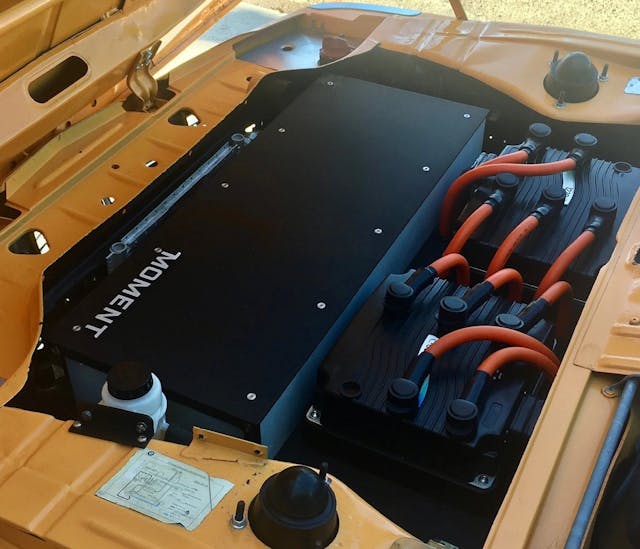
In addition, part of the converter’s design philosophy is to maintain the manual transmission and clutch, as that keeps the car fun to drive, and it doesn’t interfere with the look and feel of the gearshift lever. This car actually had a five-speed in it, which was pretty cool.
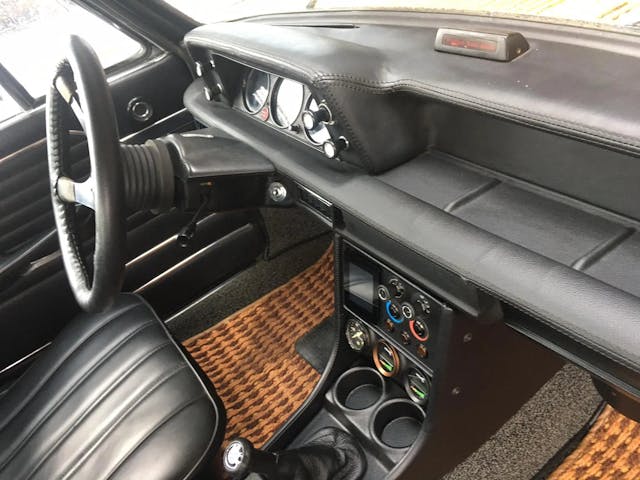
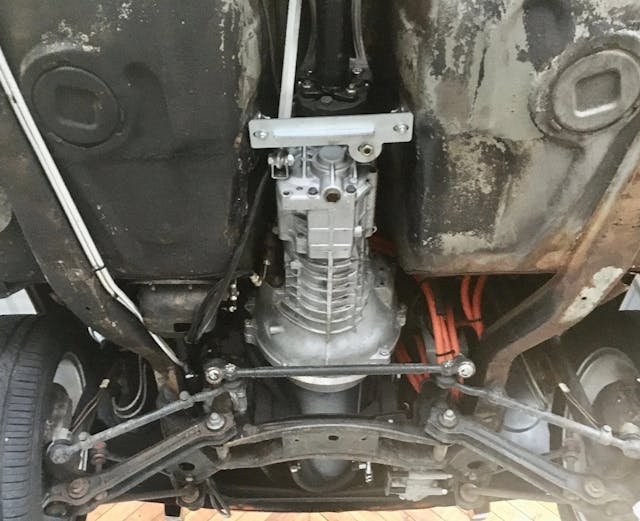
But there were some negatives. The rectangular holes for the original front bumpers’ hydraulic cylinders hadn’t been covered up; the car had been shaved (de-trimmed); it had air conditioning via a modern climate control box, whose vents were occupying the places in the dashboard where the original vent sliders were; and the dash had a stitched leather cover. OK, perhaps only the big bumper holes are a demerit, but while there’s nothing cringe-worthy with any of the other issues, there’s no denying that they collectively moved the car away from a bone-stock configuration. I’d think that from a value standpoint, a blue-chip electric-converted 2002 would be a flawless 1968–73 round-taillight car that looked absolutely stock until the hood was opened. This wasn’t that.
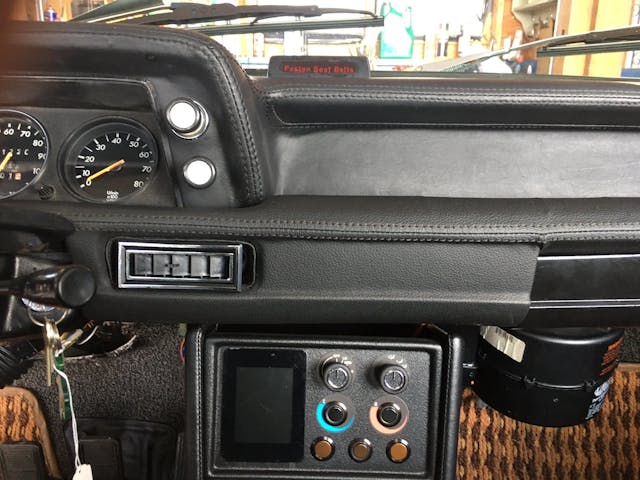

Plus, as pretty as the car’s exterior was, it had not had a rotisserie-style restoration, so the floor pans and subframes showed the small amounts of oxidation that every unrestored car has. Nothing wrong with that; every car I own looks likes this underneath. I imagined that the owner thought of the car as being in the Goldilocks zone for an electric conversion. That is, if it was too rare, too original, or too mint, you might not want to modify it, whereas if it was too beat-up or rusty, it wouldn’t be worth the expense and effort.
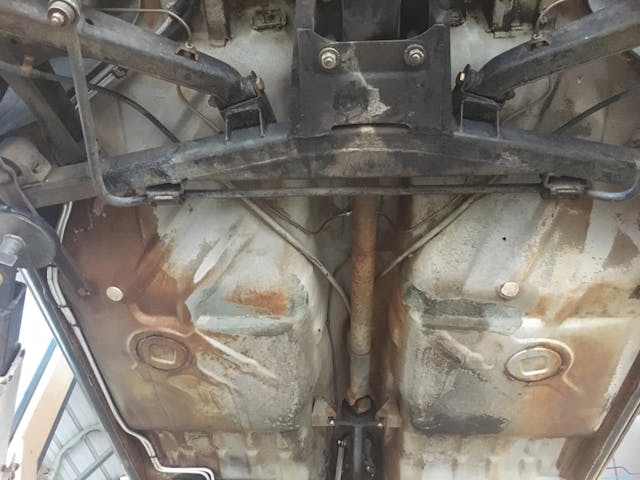
However, as I wrote when I tried to sell my 49,000-mile survivor 2002, what’s valued on BaT and causes bidding wars to head for the stratosphere are cars that present themselves in such a way that potential well-moneyed buyers think they’re bidding on a completed fully-executed whole that needs nothing. The contrast of a car’s freshly painted exterior with an original undercarriage conveys the image that the car is unfinished and holds the price on BaT down for any car. This was no exception.
The kicker was that although the car had a standard J1772 charging connector, and the conversion included a nifty adaptation of the stock gas gauge to display the reserve charge, the seller quoted the car’s range as only about a hundred miles. Gee, maybe things haven’t progressed as far as I would’ve thought since the 1972 Olympics.
Together, all these things added up to caveats that caused the bidding to top out at $42,500. Given the cost estimates listed on the conversion company’s website, I can’t imagine that the sale price wasn’t substantially less than the seller had in it.
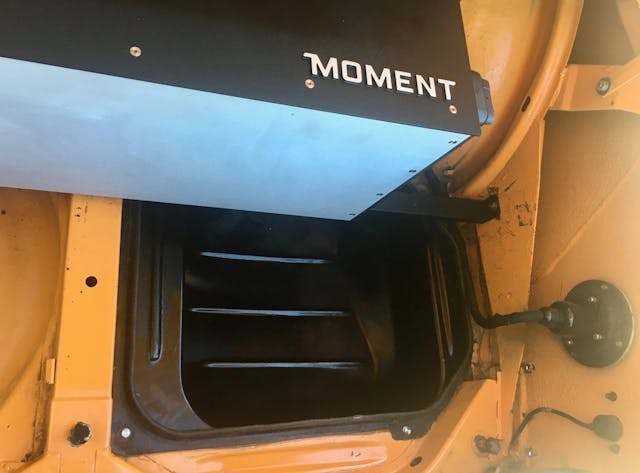
But still, $42,500 is a lot of money, at least it is to me, and that got me thinking.
As I say over and over, I am neither wealthy nor a collector. I own 13 vehicles (including a truck, little RV, and two daily drivers) because they’re either useful to me or they resonate with me in some way, but I struggle daily with both the financial and the storage repercussions. I see many cars locally on Craigslist and Facebook Marketplace that fall into what I think of as a “whim-able” price window. I used to regard this as four grand, in which all sorts of depreciated BMWs and running oddballs like Saab Sonnets, Fiat X1/9s, and ’63 Rambler 770s fall, but I’ve widened my view a bit to eight grand, as that also captures things like running but needy pre-1975 C3 Corvettes.
Still, in an environment of tightly-constrained money and space resources, the thought experiment I perform for any purchase—particularly one that’s outside my wheelhouse—is “What would I actually use the car for?” I know what I use the 1970s BMWs for. I road-trip the hell out of them. Yes, I also pleasure-drive them and use them to run errands—there’s nothing like taking a beloved classic to get milk on a Sunday morning to turn it into an event—but the road-trip part is in both my and the cars’ DNA. The Lotus Europa still hasn’t seen a big road trip, but I adore driving the featherweight little thing on twisty local roads. So, if the answer to the usage question is “I’d probably just drive it to cars and coffee a few times a year,” that’s a fail. I simply don’t have the space or the money to support owning something with that usage profile.
In truth, of course it’s less black and white than that. My 1999 BMW M Coupe (“the clown shoe”) is barely driven these days, and although my 49,000-mile 2002 did recently get a short road trip to Vermont, it’s more of an errand and a local events car. And some of my other ’70s BMWs haven’t seen a multi-day road trip in years.
But still, hypothetically, what would I actually use an electric 2002 (or any electrified classic whose range is only a hundred miles) for? That would seem to effectively rule out spirited day drives with my local 2002 pals. Yes, in theory, 30 minutes of a quick charger attached to the J1772 port should give an 80 percent charge, or another 80 miles, but that doesn’t feel like much. Me, I’d rather have the unconverted car with the range, the fumes, and the chunky rasp when I get on the throttle. And save the $42,500. Or the $50K–$150K, depending on how you want to look at it.
In my first book, there’s a chapter, titled “Restoration and why it makes no freaking sense,” in which I say that buying a car into which someone else has already sunk restoration money is almost always cheaper than spending the money yourself, but note how people pay to have cars restored anyway because it’s all about choice—what pops out at the end is the manifestation of all those choices, and so, naturally, you love it. I think that choosing to have a vintage vehicle electrified is a boutique subset of this larger restoration issue in that people who do it want to do it, probably because a) it fits their environmentally-friendly self-image, and b) they can afford it and the left-brain analytics probably don’t matter that much. I have no argument with that, but if you say that you’re doing it strictly for environmental reasons, and if your daily driver isn’t an EV, I think the justification is pretty thin. And if you say you’re doing it so you can still drive your beloved classic when gasoline is as controlled as ivory, okay, but you’re paying a very hefty premium to be on the bleeding edge. From this standpoint, the buyer of the electric 2002 on BaT made out very well.
So now I can tell you the surprising part: The BaT seller of the electric 2002 and the guy who paid to have the conversion work done was my old friend and BMW 2002 mentor from my days in Austin, Terry Sayther. Terry is 40-year member of the BMW Car Club of America, had a shop in Austin for decades, has forgotten more about 2002s than I’ll ever know, and has done a whole variety of engine swaps. In other words, the last thing he is is my hypothetical hedge-fund closet environmentalist EV-converted classic owner.
When I asked him why he did it, he said he wanted to experience an electric 2002 in the same way he wanted to experience a 2002 with a 240-horsepower S52 engine from an E36 M3 (which he also owns). He said that the electric 02 was very much a pleasure to drive, was a good city car (though more range would’ve been nice), was great to use on date nights with his wife, and, yes, did attract a lot of attention at cars and coffee events. So, you can ignore most everything I said.
Except the price tag.
If I’m still alive when gas really is akin to ivory, and the price of an electric conversion is comparable to that of an engine swap, I’ll likely change my tune (I’m above most things a practical man). Until then, you’ll recognize me because I’m the guy smiling as his car’s leaky fumy internal combustion engine is being wound out.
Really, I just want folks to be careful and realistic. The fact that an expensive boutique-converted electric BMW 2002 has only a hundred-mile range strikes me as a valuable illustration of where EV conversion technology is today and what is and isn’t reasonable to expect when you have to deal with the constraints of a vintage car. The time may come when electric conversion is the necessary and affordable way to keep driving your classic, but that time is certainly not today.
Oh, and that factory Jaguar electric E Type? Be careful what you wish for. This was the 2018 press photo of the dashboard in the prototype. If I ever owned an E Type, plunked down mortgage levels of money for electric conversion, and the interior came back looking like this, I’d want 10 minutes in a windowless room with the people who cashed my check.

***
Rob Siegel’s latest book, The Best of the Hack MechanicTM: 35 years of hacks, kluges, and assorted automotive mayhem, is available on Amazon. His other seven books are available here, or you can order personally inscribed copies through his website, www.robsiegel.com.

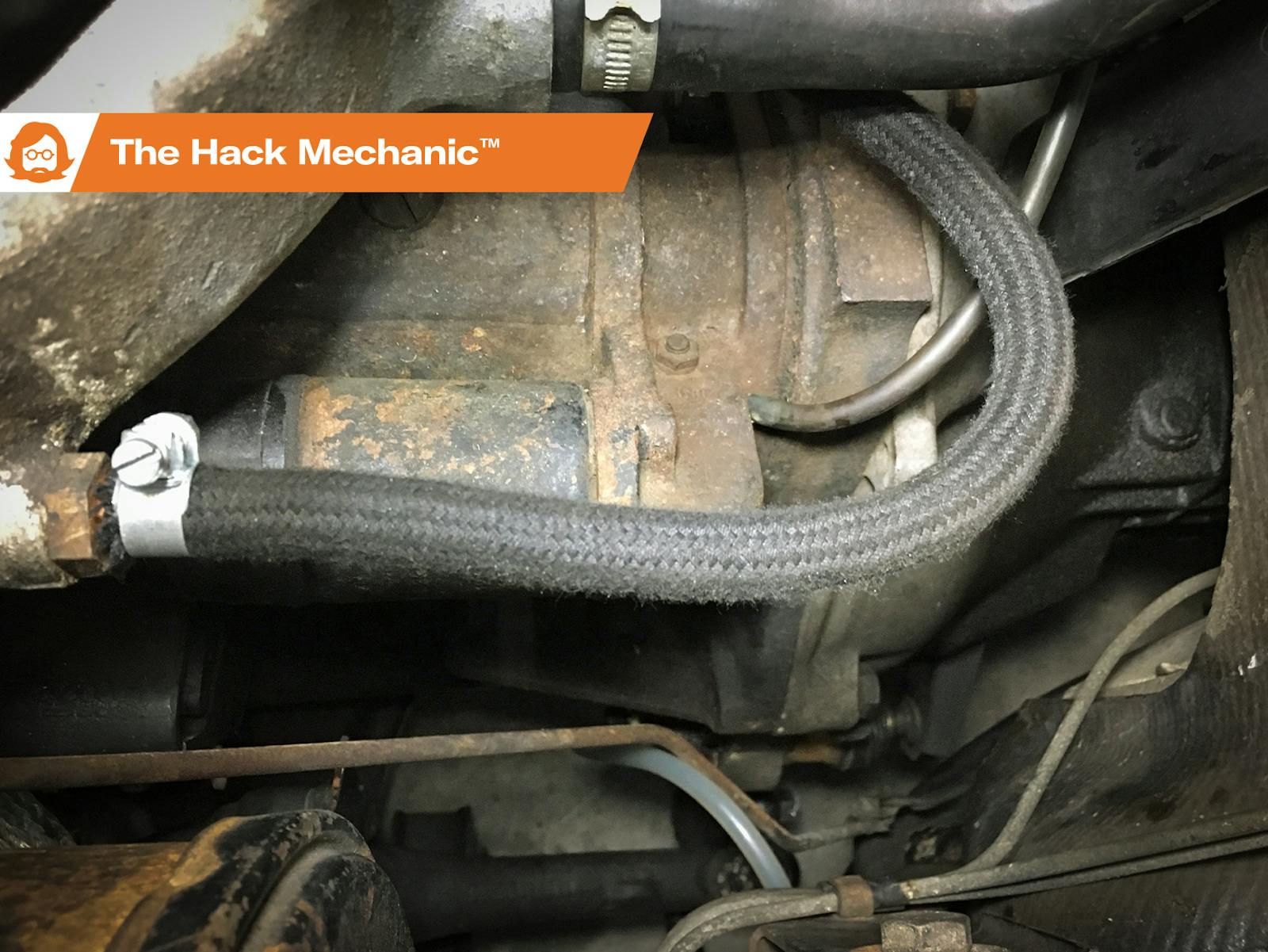
So many valid points. The 2002 that was retrofitted wasn’t rotisserie restored so the $50k+ cost was on a car that still presented as a “driver”. I’ve researched the same with the same Austin company for one of my cars. My solution, a smaller, more efficient ICE. I achieve driveability, reliability, and increased efficiency. The cost is in the $4k range.
How very true! If you want to improve your old car as far as saving the planet goes, you can any number of later engine/trans combos that you could swap in that are more efficient & reliable than the original, but often don’t change the vehicle that much as far as looks go, unless you open the hood. And often you can find an engine/trans combo from a later model of the same make that fits in the same space with better mileage AND performance!
EV conversions is a very rich mans folly for the most part. If yo want an EV go buy a car that already is. The fun of the classic isn’t just the looks, it’s the engine, transmission, steering, etc. that you get as part of the package. Let me add 100’s of pounds of weight and see if the car feels anything like it did before. It won’t
There is not enough solar or wind power to “save us”. Nuclear is the best option but we don’t seem to be willing to go that route and relying on unreliable solar, wind and batteries to save us is foolishness.
Vintage vehicles are about character and soul. Converting it to EV is removing its very essence.
I have a 1972 Porsche 914 that was converted to electric ten years ago, first using lead acid batteries, now lithium ion. I paid $3000 for it, already converted. Electric conversion does not have to be complicated or super expensive. An electric motor is much simpler than a gas engine, all you need is an electric motor, a controller, and a battery pack. I use it more now that it is electric than I would if it had a gas engine.
These guys converting classic BMW, Porsche, E-types and like, deserve the call from Liam Neeson — “I have a particular set of skills … and I will find you.”
Most of the EV conversions will increase the weight of what you are putting on the vintage suspension and breaks. Now you need more up grades.
Excellent point
What no one seems to understand is the cost of replacing the battery in electric cars, nor what to do with the waste batteries, the lack of electric grids, the lack of distance one can travel, the time wasted to recharge the battery, plus no one really knows if there are dangerous emmissions being emitted. In my opinion these cars are a bad idea. To then take a classic car and make it all electric is ludicrous.
I seem to remember an article you had in your magazine about s company that will convert your C-7 Corvette for only $750,000.00. Plus you had to supply the car. Like I said then I can buy a lot of gas at that price.
Look up the range of a Henney Kilowatt. Twice the range a decade earlier with lead acid batteries.
Hybrid seems to be a better compromise than total EV.
You have to wonder where this could go if they could make something simple and light.
Imagine 100 mpg and no stopping for a charge.
What they need is some room to allow innovation, not focused almost solely on one technology.
And have honest discussions of reality of time, cost, and additional infrastructure to support EV’s. This includes environmental impacts for the whole life cycle.
There was an article about electric semi’s. A current truck stop would require years to put in place. And enough power generated to power a small city. Think about that and the reality we have to live in. Add in losses in transmission of all this electricity, and it really hits home.
100% transmission efficiency is ignored, just like an EV has no tailpipe emissions when the bulk of the electricity is generated by mostly fossil powered plants.
I’m not against EV’s or cleaner transportation, just the fairy dust and rainbows out of the Unicorn’s backside paint used to create the picture. As Kingwood pointed out – a cleaner modern power plant can be a change that makes much more sense.
30,000 miles with my unrestored Austin sedan…not a single breakdown or failure and continues to get 39.6mpg.
Oil changes, air filters. That’s it.
50-100k for a 2002?! Ridiculous!! I’ll take my regular ICE classic car please until the “powers that be” make it illegal to own or drive.
I think that doing this to a real “classic” is sort of like having sex, but without the orgasm.
Look, most of these cars were all about the power unit, the transmission, and the feel of that, combined with the chassis, narrow tires, and the look. Make it electric and you might as well watch the drive on a lap top.
Many years ago, a real estate agent/interior decorator saw the Vienna Regulator wall clock in my home, its pendulum swinging peacefully, and remarked, “I know a guy that can convert that to an electric clock and save you a lot of trouble…”, obviously not understanding that the entire value of the somewhat exotic clock was in its movement, and not so much the style, which was pretty normal for its mid 1800s period.
I don’t have problems with the clock’s reliability (ticking accurately for the 50 years that I have owned it), though it does require regular winding of its weights back into position. Its time keeping is accurate enough that I don’t worry about adjusting it other than when time changes come along.
‘Same with my collector Morgan +8, and my Lotus 11 replica, with a hot rod BMC A series, which makes a pretty good (reliable) analog of an FWB Climax. My R5Turbo is also quite reliable when regularly serviced with fresh fuel, much as any car back in the 80s was. We drove those cars daily, and I don’t consider them to be “finicky” or “unreliable” at all. I also, due to the difficulty of trying to fix damage to any nicely cared for, original owner classic, don’t drive them on a daily basis. They are not daily drivers. Even if I had converted one of them to electric power, I doubt that I would drive it. There would be no point, without the sound, vibration and necessary skill to shift gears. I have daily drivers for that.
What is important to note here is that I am also an industry professional, as a wrench turner, journalist and photographer. I get to drive everything, and I happen to really like NEW electric vehicles. I plan to acquire one in the next couple of years, as I await the increases in range, and shorter charging times to filter down to the more affordable models (and the installation of the solar panels on my roof).
Electrifying a classic, such as an E Type is for posers. They want a “look” (sort of like wearing a ’50s bowling shirt), while not needing to know anything about the car at all. Electrifying a classic is for dilettantes making a fashion statement, and not really for enthusiasts. Fortunately, the people who like this stuff have money, and will keep the small number of conversion shops in business, just as they kept some of the conversion shops in business during the gray market years of the 80s. The work will vary from good, to very, very bad, and all of the will be very expensive. The end result will not likely be what was expected, and those cars that were converted to electrons, then back to fossil fuel will be devalued.
The BMW in question, built for a professional BMW restorer, is a pretty good case, as it really wasn’t driven much prior to its offering on BaT. Yes, he wanted to see what an electric ’02 was like, then immediately offered it for sale. Business? Sure. But also not much of a keeper.
If you want a daily driver electric, buy a new one. It will have range because it was designed around its more dense battery pack, and systems that will offer performance far beyond the abilities of any small shop to duplicate on a chassis that was never designed for the electrical demands or weight of an electric power system. The ramifications upon their driving performance will be far more than the change in power plant might indicate.
Leave the classics alone.
But… Of course, if they start to electrify old Morgans like mine, my unmolested 8 cylinder car will likely increase exponentially in value, so there is that to think about…
Meanwhile, I await my small, 350 mile range, performance sedan with 30 minute charging, and a price around $40K with the handling of an Alfa Giulia. This will happen sooner than you might think.
For entertainment, I have a Morgan, a Lotus copy and an R5Turbo. If they all outlive me (they likely will) as collector’s items, used only for pleasure, their carbon footprint will be relatively insignificant.
Invest $15000 into a $20000 car and have a $20000 car as a result. Let old cars be what they are, that’s what make them interesting. If you want an electric car that looks like an old car, build a paper mache’ body for a Prius.
Good read BUT with all the extra battery weight how does the car stop? Or does it? SPOILER with all that money spent on batteries why not go propane or hydrogen?
Rob, It is dyed in the wool not died in the wool.
Whoops, missed that one. Thanks!
Building a 100k brand new electric power train – how much environmental impact does that have. Unlikely that you are going to get the benefits of reduced emissions if you consider what it cost (emissions) to build -and use for occasional drives/cars and coffee. I would think it is much more environmentally friendly to keep driving the old ice car as it is. Same for buying ev’s. Most people who have teslas done ‘need’ them, just an extra car to make them feel good, but perhaps not buying a new car that needs to be made from dirt, producing emissions that didn’t have to be produced. How much do you have to drive your electrified classic ti start to reap the benefits of actual overall reduced emissions??
Rob, this is excellent. I agree on all points. I intend to keep driving my fossil powered cars until the whole electric trend becomes realistic both in usage (mileage) and cost. I still think we’ll see very much different new
cars on the road in 2050 than we are seeing now. Very good on conversions as well. I don’t see the point yet.
All my cars are nice Drivers; I’m not running a Museum.
And the Jag dashboard is atrocious.
Thanks again and Happy Holidays
Good points, Maestro! My daily is a plugin hybrid. At $16k, 3 years old, and with 40k mi on the clock it made financial sense. The only EV that might be able to make the same claim is the Nissan Leaf. It’s gonna be a while before there’s enough affordable EV choices. And there’s still plenty of affordable classics.